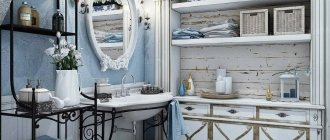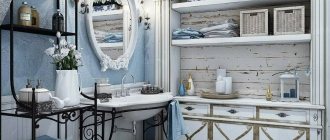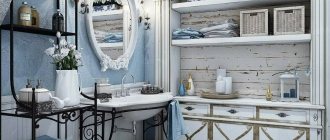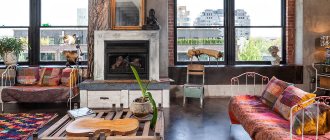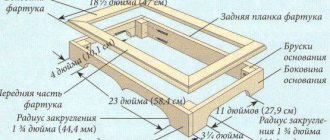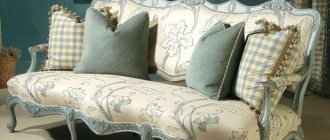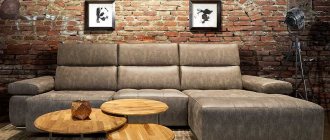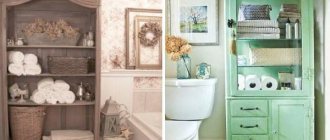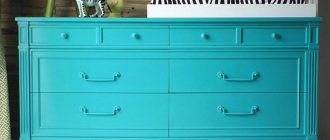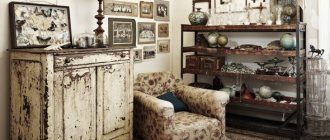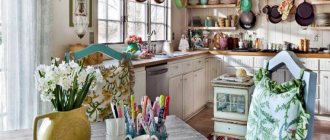Vintage interiors envelop you with special energy, homely warmth, and ease, so interest in them does not fade for years. Today, the designers of the Dekorin project will show you how to make furniture in the Provence style with your own hands. After scrolling through the photos, you will see that you don’t have to be a pro to make amazing decor. The main thing is to be patient (it may take more than one day) and use your imagination.
Decoupage wallpaper
Decoupage with wallpaper is a fairly old technology for recycling things.
It is usually used when the item does not fit well with your interior. Or it is very outdated. Most often this is furniture that is more than 10 years old. A well-chosen material and wallpaper pattern will help turn an unsuitable item into an updated version that will perfectly suit your design. The technique of decoupage with wallpaper is quite diverse. With its help, you can make improvements not only to the general structure of the subject, but also to individual things. But in order to transform things with wallpaper, some skills are required. If you are a complete beginner and want to try yourself in this creative endeavor. It is recommended to start with flat surfaces. This could be the lid of a coffee table or a cabinet door. There is quite a lot of information on this topic on the Internet. Also, for better assimilation of information, it is recommended to watch videos of decoupage in Provence style and master classes.
Decoupage coffee table
So, using the example of updating an object, we will analyze the decoupage of a coffee table. Typically, the table top is made from solid wooden boards or chipboard. In the second case, this structure is covered with plywood. I do this so that no burrs stick out from the internal structure. Also, thanks to the thin plywood, the table top remains smooth. To decoupage a coffee table with your own hands you will need:
- Varnish
- PVA glue
- Wallpaper
- Brush and roller
- Sandpaper
Sequencing:
Do-it-yourself table decoupage should begin by cleaning the slot with sandpaper. If there is polish on it, it must first be degreased and then cleaned. We carry out measuring work. Then we measure and cut the wallpaper according to these dimensions. This work must be done very carefully, because the cut will be on the front side. Apply special glue to the surface of the cleaned cover and the inside of the wallpaper. Leave for 10–15 minutes so that the paper is well saturated. Transfer the wallpaper, sticky side down, to the table top. Using a roller, level and remove air bubbles
It is important that this must be done very carefully, because the paper is very wet. At the end, everything must be coated with acrylic varnish. This needs to be done in several layers of at least 4
At the same time, take breaks between layers for 1 hour. DIY table cover decoupage is quite simple.
To avoid any problems, you should take the work responsibly. Follow all the steps and perform this work carefully. The end result will be a unique and beautiful thing. Also, to visually see each process, it is recommended to watch the video of the master class. Decoupage a chest of drawers without much difficulty This master class is created for beginners. Therefore, there should not be any big problems with updating furniture. This technology involves decoration using cards. Typically, this method is used if you have a chest of drawers that you are already tired of, and besides, it doesn’t fit well with your design. Materials required for decoupage:
- Sandpaper
- Paint roller or brush
- Protective gloves
- White paint
We start decoupage by cleaning all surfaces. After that, apply white paint. It is best to use a roller for this. Paint must be applied to all surfaces. Leave the painted structure to dry. Cut out decoupage cards
It is important that this is needed as close to the edge of the drawing as possible. After the chest of drawers has dried, we lightly sand it with sandpaper to give it an aged effect.
The result should be slight roughness that will give the furniture uniqueness. Carefully apply glue to the decorative parts. You can use any glue, but PVA is best.
Then we glue them to the structure. Level and remove air bubbles. Glue decorative cards not only on the front side, but also on the sides. So, it is recommended to place the largest parts in the middle. Smaller on the bottom and top of the chest
It is important that the glue is applied evenly. The main problem is decorative paper getting wet
This is due to excess glue that tangles the paper too much. As a result, when gluing the pictures, they tear in your hands.
Also, in dismantling you can use not only drawings, but also curls and monograms. You can paint them using a simple paint brush. At the end, if desired, the chest of drawers can be coated with several layers of varnish. There should be at least 3 of them, a break between applications of 3 hours.
Step-by-step instruction
Let's consider the procedure for decoupaging a cabinet in Provence style.
First of all, think about the pattern that will be applied to the surface. In accordance with the invented design, a stencil is made from low-density paper. After this, acrylic paint is applied to the prepared surface (cleaned of dirt and dust, and thoroughly cleaned). It should be applied in two layers.
The surface is covered with a primer; after it has dried, you can proceed to painting the main background.
After this, the prepared images are applied to the places previously determined for them, and a layer of glue is applied over the images. It is better to do this procedure using a small brush - it will be more accurate, and you will definitely not miss the attached pictures. The glue must dry completely, so the surface is left for at least one hour.
The pattern is straightened with a brush, being careful not to damage it, then it is glued with another layer of glue, applying it on top of the pattern.
Then a clear varnish is applied and left for several hours until completely dry. After the clear varnish has dried, another layer of varnish is applied, but this time it is water-based. With the help of a regular hairdryer and water-based varnish, it is possible to create an amazingly beautiful effect of blurred paint.
After the process, it is recommended to leave the furniture for at least three hours.
A layer of bronze or gold paint is applied along the contour of the resulting pattern. This seemingly unnoticeable little step will give your closet an antique charm and make it look luxurious.
The above method of creating decoupage is considered the easiest to implement. Even a person who does not have the slightest artistic skills can create a masterpiece in this way. Fortunately, today you can purchase all the necessary materials to create unique images on pieces of furniture.
Decoupage furniture in the Provence style allows you to create a corner of southern France in your room.
Another interesting technique for applying images is called spattering. Thanks to it, you get interior elements that are ideal for the Provence style. The process is also considered easy to perform. You will need dark paint and a stiff bristled brush. After the image is applied to the surface of the cabinet, table or chest of drawers and covered with a top layer of varnish, a brush, previously dipped in paint, is brought to it and a gloved hand is passed over the bristles.
After the varnish has dried, the furniture can be used for your pleasure.
Decoupage technology involves performing a series of actions on furniture, after which the interior items get an aged look. This process is completely simple, and even a beginner can cope with it. It is this finishing that allows you to end up with a unique, almost antique item that fits perfectly into the Provence style.
How to age furniture using wax and a stencil - master class
This method of decorating furniture helps to solve a familiar problem, when any piece of furniture has served for some time and has lost its original appearance, but at the same time remains strong and reliable in terms of quality. In this case, you can give it a second life using this artificial aging technique, which is in some ways similar to the methods described above, but in some ways different from them.
Of the additional tools and materials not described in the corresponding section, we will need:
- black and white acrylic paints, preferably white aerosol;
- white paraffin candle;
- rubber lace napkin;
- parquet or furniture varnish.
To achieve the best result, you need to carefully and consistently follow all the points of the following instructions:
- as a preparatory stage, the piece of furniture to be decorated must be sanded with sandpaper, first coarse, then fine, in order to remove remnants of old paint or varnish;
- Take a brush with artificial bristles and completely paint the work surface with two layers of black acrylic paint. The second layer is needed to level the first;
- Next, use a paraffin candle to rub the edges, corners and other protruding places of the furniture, which would most likely be worn out over time. This action is necessary so that during the subsequent application of paint it will be possible to remove it in those places where it lay on the paraffin;
- Now we take a lace napkin, which will play the role of a stencil, and fix it on the part of the furniture where the design will be appropriate: if it is a chair, then on the back or seat, if it is a cabinet or bedside table, then on the door or roof, etc. After this, use a can of white paint to paint the entire surface of the product. It is advisable to do this outside, but if this is not possible, then you need to at least cover the floors with newspapers, film or cardboard, otherwise everything around will be covered with splashes of paint;
- When the paint is completely dry, use a sponge to clean the areas that you rubbed with paraffin before painting. You will see dark paint showing through the top white layer. After this, you can remove the napkin;
- At the end of the work, it is better to cover the surface with parquet varnish to extend the life of the new coating.
In conclusion, I would like to say that personally aged wooden furniture, photos of which you see in various versions on this page, is something that will bring a fresh air into your life, allow you to rise above routine and give you the opportunity to be proud of the unique atmosphere in your home and the fruits of your skillful hands.
https://youtube.com/watch?v=-aReasBMbHU
Distinctive features of the style
This fashion trend originated in 18th-century France as a design element for country houses and estates.
Such dwellings had their own characteristics. These include decorating walls with simple paper wallpaper with floral and plant motifs, which would symbolize closeness to nature. There are other options: discreet plain wallpaper in harmonizing colors, natural motifs that look especially impressive if they are in harmony with the landscape outside the window. Also, the walls began to be decorated with expensive textiles and wood panels.
Since houses of those years were built extremely simply, load-bearing wooden beams under the ceiling often remained uncovered in the rooms. It happened that they were not even painted. Modern designers deliberately use this technique, sometimes attaching such beams artificially. The combination of rough wood texture and delicate floral motifs creates a touching and stylish contrast.
This interior is characterized by natural materials. Furniture in this style must certainly be very elegant. Forged interior elements, which always look unusual, are suitable. Beds are most often made this way, but dressing tables, cabinets and other items are also found.
Also perfectly combined with this style are carved wooden cabinets, bedside tables and chests of drawers, especially those that are deliberately “shabby” or antique-style. They are very atmospheric and textured, which is why they are so good for this style.
The color scheme of the Provence direction is gentle and close to nature. Pastel colors are often used here: delicate shades of blue, lilac, pink, beige, olive, mint, lavender, etc. They can be diluted with white or gray, or combined with each other. The texture of natural wood, especially bleached wood, is welcome.
Accessories are very important for this style. First of all, in such an interior there is a lot of textiles, ruffles, and frills. This can be bedspreads, tablecloths, lace napkins, upholstery and lampshade fabric. Since the most common Provence pattern is considered to be a small floral pattern, you need to make sure that the design of the textiles matches the walls, and that the variety of colors does not dazzle your eyes.
There are always a lot of various decorative little things in such rooms. You can experiment with wooden and wrought iron photo frames on bedside tables and walls.
Such rooms should have a lot of light and space. Often, to achieve this, several small mirrors are used, located in different corners of the room.
Curtains on the windows should be light and weightless, otherwise the abundance of fabric and decorative trinkets will make the room look like a chest.
Provençal cuisine
One of the main rooms of any home is the kitchen. It looks especially beautiful in Provence style. Light walls, high-quality wooden cabinets, shelves and chairs in natural colors or warm pastel colors, original decorative items, an abundance of spices, and the presence of free space - these are the main features of Provencal cuisine.
If space allows, an open hearth with a large wooden, stone or brick façade is appropriate. High ceilings can be decorated with artificially aged wooden beams, onto which several lamps can be secured using forged hooks. You can also beautifully place kitchen utensils on them.
There shouldn’t be a lot of forged decorative parts – just a few “antique” items are enough. These are a fireplace grate and tongs, one or a pair of candlesticks, furniture handles. In this case, you should not apply gilding to forged parts - it is better to create an imitation of a light patina.
Interior decoration in Provence style
Provence style decor
For curtains on kitchen windows in the Provence style, you should use natural materials - linen, chintz, cotton with a small addition of viscose. The color palette of curtains for the kitchen is also limited to pastel shades of the background, but they can have a bright floral pattern or print - the size of the window should be taken into account here. A fabric that is used for upholstering kitchen furniture or a canvas that matches the color scheme is suitable. The shape of curtains for the kitchen can be varied - these are stained glass curtains, Roman, roller, cafe-style or full-fledged curtains. The choice of shape depends on the size of the window and the area of the kitchen. Light wooden blinds, painted to match the basic tone of the interior, look interesting.
We must not forget about kitchen lighting. After all, the Mediterranean is an abundance of sunshine. If the kitchen window is small or faces the north side, it is necessary to compensate for the lack of natural light with the help of lamps, placing them above the kitchen work area and the dining table.
Interior decor in Provence style
Design decoration idea in Provence style
Modern decor in Provence style
See alsoCandle decor - hobby and interior decoration
Features of the Provence style
Provence is a more sophisticated analogue of American country. The style of the French countryside is distinguished by both simplicity and sophistication, elegance and modesty, an affinity for vintage furniture, naivety and idyllic tranquility. It is sincere and cozy, like a grandmother’s village house from childhood memories. It is especially common in kitchens, but can also decorate other rooms: living rooms, dining rooms, bedrooms.
Rare or antique furniture is very elegant and beautiful, but not everyone can afford this pleasure.
Style Features:
- Antique or artificially aged furniture.
- Natural flowers.
- Decoration with floral and rustic ornaments.
- An abundance of things from the “good old days,” from grandma’s box to antique trinkets bought at a flea market.
- Decoupage, sewing, ruffles and other handmade decor, made with your own hands.
- Softness, naturalness and variety of materials.
Slightly “faded” and dull colors, rustic but practical and high-quality things, rough plaster and natural textiles - this is interior design in the spirit of “French country”. There is no place for pomp, deliberate pretentiousness and arrogant luxury. The cold shine of metal, polished surfaces and modern furniture “monsters”-transformers are inappropriate. Everything is homely, cozy and modest, but at the same time subtly elegant.
Before you start aging furniture on your own, it is necessary to thoroughly prepare all wooden surfaces that will be processed.
The second stage - creating a stylish shabby look
Yes, you heard right - this is the artificial aging of furniture with your own hands. Those who in childhood loved to paint with watercolors and use everything they could get their hands on as tools know what intricate patterns were left by the remains of a candle on thick paper. And in front of us is a tree. To create shabby corners we need paraffin. We rub it on those areas that should stand out.
Afterwards you will see how easily the paint will come off from areas treated in this way. But we are just waiting for this.
Types of cabinets
Sliding wardrobe in Provence style
The Provence style is characterized by the following types of cabinets:
- Depending on the type of storage they are intended for: kitchen cabinets, hallway cabinets, storage cabinets
- By type of construction. For example, a display cabinet made in the Provence style is perfect for a kitchen or living room, the upper part of this design will be made using glass, you can put dishes there, and the second half of the cabinet can be used, for example, for books or other things that you would not like demonstrate.
- A cabinet with features. If this style is a classic French country style, then it is not necessary that all cabinets decorated in this way should be the same. For example, you can add personality to the way the doors open: they can diverge to the sides, open up, or ride on a rail, like in a wardrobe.
Wardrobe with decoupage in Provence style
The decor should naturally please the owner, but excessive brightness and frequency of patterns should also be avoided. The principle of moderation must be observed; Provence style cabinets should not be a bright spot in the interior
They should dilute it and focus attention. All colors used in decoration should be muted and of the correct shades
When decorating cabinets, you can use any methods of applying patterns, the main thing is to emphasize the aged charm. Usually they use hand painting on wood, but such work is very complex and, if you are not an artist, it will be difficult to complete. You can also decorate furniture in the style of decoupage or stencil paint. Wood carving is welcome. But also such elements should not stand out from the general background.
In the apartment
Provence style is easier to create on a large area, which can only be in a private house or luxury apartment. But don't despair if you live in a small apartment. Here you can also recreate the presented design, but only taking into account some details.
- Firstly, it is better to give preference to light shades. The wood should be painted in light milky shades; in this case, ivory color has gained wide popularity.
- Secondly, it is better to choose only wallpaper for wall decoration. Using two shades, you can create an attractive combination for zoning a room or simulating wooden wall panels.
- Thirdly, the color of the kitchen set in a small kitchen should not be the darkest tones. The tabletop can be made light in accordance with the shade of the walls.
Read a separate article for more details on how to decorate a small kitchen in Provence style.
There are several rules here, but the designers themselves claim that this style “withstands” whatever the young housewife desires.
In the video you can see an example of a kitchen interior in the Provence style.
Before getting down to business, you should find out exactly what the young housewife wants. Since the chosen style allows you to show your imagination, this opportunity must be taken advantage of.
- First, decide on your furniture choices, including kitchen cabinets, which are essential for storing multiple sets of pots and plates.
- Secondly, take a walk to the flea market in your city; perhaps there, for a nominal fee, you will find a lot of interesting things, which will help you get an overall picture of your future kitchen.
- Thirdly, it would be useful to look in the bins of the garage or attic for old things that can later be restored according to the chosen color scheme and texture.
How to make a “provincial” clock
The interior, decorated in Provence style, does not allow the presence of modern details. Finished vintage watches are very expensive. But you can make a “provincial” watch with your own hands - and you can create an exclusive copy that will be the envy of all your friends.
To make the watch we will again use the decoupage technique. We will need:
- clockwork;
- wooden or plywood blank for the dial;
- primer paint;
- drawing for decoupage;
- PVA glue;
- brushes, sponge, water;
- clear nail polish.
We purchase a clock mechanism or use an existing one from an old but working clock.
Interior decoration in Provence style
Provence style decor
In handicraft stores you can purchase wooden blanks for the dial and stencils for decoupaging a watch in the Provence style with your own hands. Or you can cut out the base from multi-layer plywood. Provence style watches can be of any shape, the dial is located exactly in the middle or offset to one of the sides.
Let's get to work.
- The workpiece must be sanded well with sandpaper, especially the sawn-off end parts.
- If you use a plastic base, degrease it well before working.
- Mark a hole for attaching the clock mechanism and hands, and also attach a mount for hanging on the back wall.
- Prime the wood base with white paint or a selected shade of pastel color to create a general background.
- Mark the dial in any convenient way, taking into account the general pattern of the base.
- Carefully tear out the selected design elements from a napkin or decoupage stencil and glue them onto the base using a brush and PVA glue diluted with water. It is better to tear off the edges of the drawing, so it will fit more organically onto the base. Avoid the formation of paper folds when gluing; if they appear, try to smooth the pattern with a sponge.
- Let the workpiece with the pasted pattern dry, then cover it with a layer of acrylic varnish. After the first layer has dried, repeat the operation again, covering the watch base with three layers of varnish.
- After the workpiece has completely dried, stick numbers on the marked places (they can be made from any natural materials, especially if the clock is intended for the kitchen), or carefully apply them with dark paint using a stencil.
- Secure the clock mechanism on the back side, and install the hands on the front side.
Your exclusive watch is ready - you can hang it on the wall and surprise your guests with your talents!
Create a cozy, sweet interior in the Provence style yourself, regardless of whether it is a private house, a city apartment or a separate room. Your main assistants should be your imagination, the desire to create, and, of course, the advice of experienced designers. A mandatory addition to the created interior should be decorative elements, united by a common idea, purchased or made independently using available techniques.
Fifth stage – patience and work will grind everything down
We don’t need to grind anything - just achieve light wear, as in the photo of furniture that has undergone artificial aging with our own hands. This is where the base coat of paint comes in handy - it will show through on the treated area.
After drying, take a fine piece of sandpaper (or a large one, depending on the effect we are trying to achieve) and rub the surface until the excess paint comes off and the color itself is half erased.
I’ll add on my own – this is real magic with your own hands. It is difficult to remain indifferent to the process. But if you are afraid of spoiling the thing and grieving afterwards, entrust the production of furniture in an aged style to the professionals from FOREST GROUP.
Types of furniture in Provence style
When choosing furniture for Provence, you should give preference not only to its functionality, it should bring aesthetic pleasure to the owners of an apartment or private house. There are various models characteristic of this style, which are widely used in our time.
Pastel colors – classic French style
What types of tables are there in Provence style?
A characteristic feature of the tables that are chosen for French-style interiors is their shape. To save space, many people prefer rectangular products - they can be placed along one of the walls. Round and oval ones are placed in the center of the room. Manufacturers often offer sliding models, which can accommodate a large number of guests for festive dinners.
Natural wood is used to produce tables; the final version can be varnished or painted in light shades. A distinctive feature of the models is the legs: they can be curved or carved.
Another option for tables is forged models with figured elements. They can be in natural colors, but more often there are products painted white.
Decorating chairs in Provence style
For chairs in the Provence style, only solid wood is used. The models look elegant in the interior on the one hand, and simple on the other. They are painted in pastel colors; for upholstery and covers they choose natural materials in calm colors, for example a small floral print.
The frame has smooth lines, complemented by carved details and elegant patterns - this is the main difference from the country style. It may show signs of aging, minor abrasions, scratches and even chips.
Features of choosing sofas in Provence style
Provence style sofas are made from solid wood, and forged and wicker models are also very popular. They have special requirements:
- they should be comfortable;
- complement the overall style of the room;
- be an interior decoration.
Sofas come in different sizes, but compact models are best. They are almost always decorated with decorative pillows, which give the interior a cozy look.
Modification of chairs in Provence style
Armchairs always act as an accent in the interior; large backs, decorated with lace capes with tassels, will make your stay more comfortable. A great option for Provence is a rocking chair: you can relax on it on long winter evenings by the fireplace while reading your favorite book or doing handicrafts.
Another modification is a chair-bed; it will fit perfectly into the interior of a child’s room, bedroom or even living room and will help out in case overstaying guests decide to stay overnight.
Optimal storage systems in Provence style: cabinets and chests of drawers
Furniture in an interior decorated in Provence style occupies a key position and sets the tone for the entire room. Therefore, the choice of storage systems, for example, cabinets, should be approached as carefully as possible:
- facades must show signs of aging, for this they use different techniques;
- carved elements, modeling, forged parts on facades are welcome;
- The facades decorated with hand painting look very beautiful.
Natural wood is used to make cabinets. All additional decor on massive surfaces looks gentle and elegant.
Rules for choosing a bed in Provence style
Beds are most often made on a wooden or forged frame. Aged surfaces fit perfectly into the Provence style
Particular attention is paid to the back and legs, which can be figured with carved elements
Bronze, brass or iron are used for forged frames - thanks to special techniques they do not look bulky in the interior, and additional curls create the impression of openwork lace, emphasizing the weightlessness of the structure. You can choose a model for a spacious bedroom, and manufacturers also produce compact products for the nursery. As an addition, a canopy is often installed above the headboard, which gives the room a romantic mood.
Related article:
How to do it yourself?
Before you start decoupage, you need to choose the piece of furniture itself (in our case, it’s a chest of drawers). The selected piece of furniture must be suitable for the Provencal interior. It should have elaborate legs and carved elements. For work you will need to prepare the following materials and tools:
- detergent;
- degreasing liquid;
- primer;
- acrylic paints;
- tassels;
- sponges for painting;
- scissors;
- decoupage varnish;
- glue;
- napkins with floral patterns;
- craquelure varnish;
- baguette paste.
ATTENTION: the varnish for furniture decoration is chosen special, intended for decoupage. If this is not available, you can use wood varnish
It must be matte.
Most often, special decoupage napkins are used for gluing drawings, which can be purchased at handicraft stores. They consist of three layers and are sold individually. The range of these products is so wide that the buyer will definitely select the desired ornament for decoupage.
IMPORTANT
Special napkins for decoupage easily blend into work surfaces, and after sanding and applying several layers of varnish, their boundaries are not visible on objects.
Master class on chest of drawers decor
The following preparatory work is carried out:
- All surfaces are cleaned of dust using a damp sponge and detergent.
- After the chest of drawers has dried, the surfaces are sanded with sandpaper until they become perfectly even and smooth, and if necessary, the old layer of paint is removed from them.
- Surfaces are degreased and primed.
- After the primer has dried, the chest of drawers is painted in the main color with acrylic paints (in our case, a beige tone was chosen). To do this, paint is poured into a disposable plate and applied to the chest of drawers with a special velor roller or medium-sized brush. After the paint has dried, you can begin the decoupage technique itself.
- A design is cut out of napkins and laid out in the places where it will be located on the chest of drawers. The base of the chest of drawers is coated with glue in advance.
- The cut and glued napkins are carefully straightened with a brush, and another layer of glue is applied on top of them.
- The edges of the ornament are decorated with paint.
- The piece of furniture is set aside until all layers are completely dry. To speed up the process, you can use a hairdryer.
- Gray paint is used to paint the rims of the drawers and the sides of the chest of drawers.
- Craquelure varnish is applied on top of the beige base in two layers. Before each application, you must wait until the first layer has completely dried.
- The cracks caused by the varnish are filled with gold pigment.
- The entire chest of drawers is treated with aqualac.
- Next, monograms are drawn on the drawers and sides using baguette paste, which are then decorated with gilding.
- All edges of the furniture are treated with a sponge dipped in acrylic paints (gold, green, brown and black alternately).
- The chest of drawers is coated with finishing varnish.
IMPORTANT
The most difficult workflow in the decoupage technique is the careful application of napkins to the surface. They should not form wrinkles or bubbles from air and lumps of glue. When working, it is worth considering that napkins wet from glue are easily torn.
Pillows
You can update your rustic interior with the help of self-made pillows. They will give the room more warmth, comfort and a pleasant homely atmosphere.
When sewing a pillow, natural fabrics in soothing colors are chosen. They are embroidered with satin ribbons or lace.
Diamond IMPORTANT: it is recommended to use synthetic materials (holofiber or padding polyester) that are hypoallergenic as pillow filling.
When sewing a decorative pillow, the main thing is:

